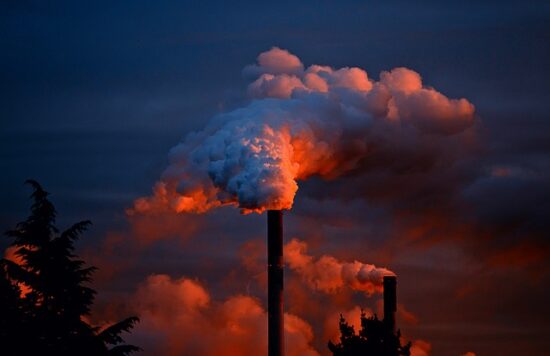Smoke is one of the forms of air pollution. Various natural sources emit smoke into the atmosphere. Humans are mainly responsible for making the air dirty because man-made activities result in producing a large amount of hazardous substances in the air. These substances are so toxic that they actually change the composition of gases in the atmosphere.
Thus, air pollution can be defined as poisonous substances (gases or liquids) that exist in the atmosphere in so large a quantity that they are harmful for living organisms including humans.
Air Pollution for Kids | Types of Air Pollutants
- Primary
- Secondary
Primary Air Pollutants
Carbon oxides
The two gases collectively known as carbon oxides are named as carbon monoxide (CO) and carbon dioxide (CO2).
Carbon dioxide is a major source of global warming.
Carbon monoxide is a colorless gas with no smell. It is extremely toxic for humans because it inhibits breathing. When you inhale carbon monoxide, your blood will be unable to carry oxygen.
Nitrogen oxides (NOx)
When chemicals like nitrogen and oxygen combine as a result of burning of fuel, gases in the form of nitrogen oxides are produced.
Nitrogen oxides are very harmful for the growth of various plants. When humans sniff nitrogen oxides, these can make their health issues even worse.
One of the ingredients of nitrogen oxide is nitrous oxide (N2O), which is causing global warming and is also reducing ozone from the atmosphere. Nitrogen oxide also wears away metals.
Sulfur dioxide (SO2)
Sulfur dioxide is a colorless gas with a very strong aroma. When chemicals like sulfur and oxygen combine in the air, they give rise to gases called sulfur oxides. These gases eat away buildings, stones and metals through corrosion.
Particulate matter (dust and mist)
These are tiny particles of solid and liquid hanging in the atmosphere like particles of soil, salt of seawater, soot, small drops of sulfuric acid and the like.
They spread out rays coming down from the sun and also have the capacity to absorb them.
That’s why people living in countryside tend to receive more sunlight as compare to cities because the dust particles exist in greater quantities over cities. During damp conditions, these particles wear away buildings and metals. As compare to larger particles, smaller ones are even more harmful because humans breathe in and carry them into their lungs.
Hydrocarbons
As the name suggests, these compounds consist of hydrogen and carbon.
Methane (CH4) is a hydrocarbon gas. It is a colorless gas and it is a very important ingredient of natural gas. It is also one of the main gases causing global warming.
Benzene is another example of liquid hydrocarbons.
Not all hydrocarbons are harmful for humans but few of them can cause cancer.
Secondary Air Pollutants
Ozone (O3)
Ozone is a component of oxygen. It performs a very important function in stratosphere (an upper layer of atmosphere) because it blocks harmful Ultraviolet radiation (UV) of sunlight from reaching the earth’s surface. This way it protects us. But it is also present in the lowermost layer of the atmosphere (called troposphere) as an air pollutant. The radiation of the sun allows hydrocarbons and nitrogen oxides to react with each other, thus emitting ozone. It is a source of creating health problems and diminishes one’s ability to see clearly in the air. It is also very harmful for the growth of plants and agricultural crops. It is one of the main causes of global warming too.
Sulfur trioxide (SO3)
As sulfur dioxide comes into contact with oxygen (in the air), sulfur trioxide is produced. It is an air pollutant.
Various acids
When sulfur trioxide (SO3) combines with water (H2O), they give rise to sulfuric acid (H2SO4). Sulfuric acid is also a secondary air pollutant.
Sources of Air Pollution
Natural Sources
Apart from man-made sources, there are some natural sources that are constantly causing air pollution. The volcanoes release small particles into the atmosphere in the form of sulfur oxides and other dust particles.
Some of the hydrocarbons released by plants into the atmosphere also change the percentage of gases in the air (thus causing air pollution). These hydrocarbons are produced on heating of leaves and then combine with substances in the air.
Man-made Sources
The major sources of air pollutants in the air are burning of fuel in industries like power plants and the release of harmful gases by the vehicles. The power plants produce sulfur oxides, ash and nitrogen oxides. The burning of trees in a forest produces a large amount of smoke and contributes to air pollution.
Stationary Sources
Power plants
Mobile Sources
Diesel trucks
Cars
Heavy vehicles used for building and construction
The dust (particulate matter) released by 150 vehicles combined is equal to the dust released by the engine of just one heavy truck.
Trains
An engine of a diesel train releases 10 times more dust than single engine of a diesel truck.
Tractors
Percentage of Contribution to Air Pollution
Vehicles | 57 percent
Burning of fuel | 21 percent
Industries | 12 percent
Others | 10 percent
Effects of Air Pollution
Air pollutants:
- damage living organisms;
- decrease one’s ability to see clearly through the air;
- wear away buildings, metals, stones and clothing;
- are very harmful for respiratory tracts of humans (and other living organisms);
- cause redness in the eyes of humans;
- make health problems worse like those relating to lungs and pneumonia;
- injure immune system of humans that fight against the bacteria and protects us from getting sick;
- decrease the growth of plants and crops
- cause global warming and destroy ozone (from the stratosphere which protects us from harmful UV sunlight rays)
Leave a Reply